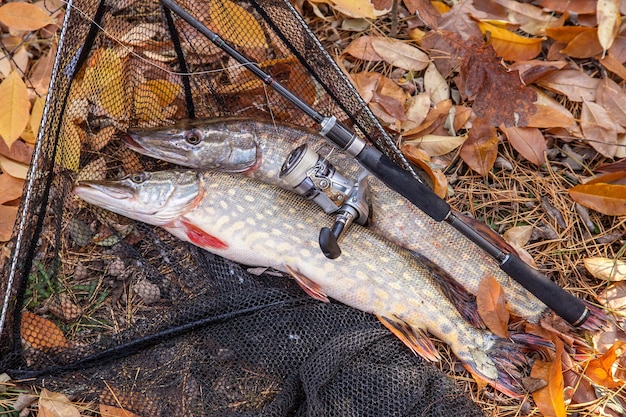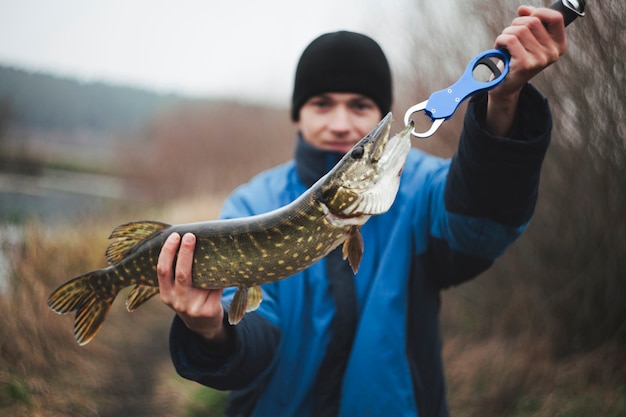Pike fishing is an exciting adventure waiting to be explored, and whether you're a seasoned angler or just starting out, there's always something new to learn. In this blog post, we'll guide you through the essential tips to spot pike in any season, so you're well-prepared no matter the time of year. From choosing the best pike lures to understanding the perfect fishing gear for pike, we'll help you enhance your skills and confidence on the water. We'll also cover seasonal pike fishing techniques that will give you an edge and help you avoid common pike fishing mistakes. So grab your rod, and let's embark on a fishing escapade that promises not just a great catch but unforgettable memories.## Mastering Pike Fishing Gear.
To catch pike successfully, you need the right tools. Let's explore the essential gear that will set you up for pike fishing success.
Choosing the Right Rod and Reel
Selecting the perfect rod and reel combo is crucial for pike fishing. A medium-heavy to heavy action rod, typically 7 to 8 feet long, offers the backbone needed to handle large pike and cast heavy lures.
For reels, baitcasting models are popular among pike anglers. Look for reels with a high gear ratio (6.3:1 or higher) to quickly retrieve lures and control active pike.
When pairing your rod and reel, balance is key. A well-balanced setup allows for longer casting sessions without fatigue and better lure control.
Best Pike Lures and Baits
Pike are aggressive predators, and choosing the right lures can make all the difference. Spoons, crankbaits, and large soft plastics are all effective options.
Spoons mimic injured baitfish and create flash and vibration that attract pike. Crankbaits, especially those that dive deep, can trigger strikes from pike lurking in deeper waters.
Soft plastics, like swimbaits or large curly-tail grubs, offer a more natural presentation and can be effective when pike are less active. Remember, pike have large mouths, so don't be afraid to use bigger lures.
Essential Fishing Gear for Pike
Beyond rods, reels, and lures, there are several other items you'll need for a successful pike fishing trip. A sturdy landing net with a long handle is crucial for safely landing these toothy predators.
Wire leaders are a must to prevent pike from biting through your line. Pliers or forceps help with hook removal, while gloves protect your hands when handling pike.
Don't forget a first aid kit and sun protection. Pike fishing often involves long days on the water, so being prepared for various conditions is key to an enjoyable experience.
Seasonal Techniques for Pike Fishing

Pike behavior changes with the seasons, and adapting your tactics accordingly can greatly improve your success rate. Let's look at how to approach pike fishing throughout the year.
Spring and Summer Pike Tactics
Spring and summer offer exciting pike fishing opportunities. As waters warm, pike become more active and move to shallower areas.
In spring, focus on areas near spawning grounds. Pike often hang around these spots to feed on other spawning fish. Use slower presentations and target areas with emerging vegetation.
Summer brings warmer water temperatures, pushing pike to cooler, deeper areas or near structures that provide shade. Early mornings and late evenings can be particularly productive during this time.
Try topwater lures in summer, especially in areas with lily pads or other surface vegetation. The explosive strikes of pike on topwater baits are thrilling and highly effective.
Fall and Winter Pike Strategies
As temperatures drop in fall, pike feeding activity increases as they prepare for winter. This can lead to some of the year's best pike fishing.
Target areas where baitfish congregate, such as river mouths or deep holes. Large lures that imitate the local forage can be very effective during this time.
Winter pike fishing requires patience and precision. Ice fishing is popular, but open water fishing can also be productive. Focus on deeper areas where pike congregate in colder months.
Use slower presentations in winter, as pike metabolism slows in cold water. Vertical jigging or slow trolling with large baits can entice lethargic pike to strike.
Finding Pike: Tips and Tricks

Locating pike is half the battle in pike fishing. Understanding their preferred habitats and how to read water conditions can significantly improve your chances of success.
Understanding Pike Habitats
Pike are ambush predators that prefer areas with cover to hide and wait for prey. Knowing their favorite spots is crucial for successful pike fishing.
Look for weed beds, fallen trees, and rocky points. These structures provide cover for pike and attract baitfish, creating perfect hunting grounds.
In rivers, focus on areas with slower current, such as backwaters or eddies behind large rocks. Pike use these areas to conserve energy while waiting for prey to pass by.
During warmer months, shallow bays with vegetation are prime pike territory. As temperatures cool, pike often move to deeper waters near drop-offs or underwater structures.
Reading Water Conditions for Pike
Understanding how water conditions affect pike behavior can give you a significant advantage in locating and catching these predators.
Water temperature plays a crucial role in pike activity. In spring and fall, when temperatures are moderate, pike are often more active and found in shallower waters.
Clarity is another important factor. In clear water, pike rely more on sight and may be more cautious. Use more natural-looking lures and longer casts. In murky water, opt for lures that create more vibration or noise to attract pike.
Pay attention to wind direction and strength. Wind can concentrate baitfish in certain areas, and where there's bait, there are often pike. Fishing the windward side of a lake can be particularly productive.
Consider the time of day and light conditions. Pike are often more active during low light periods like early morning or late evening, especially in clear water bodies.

